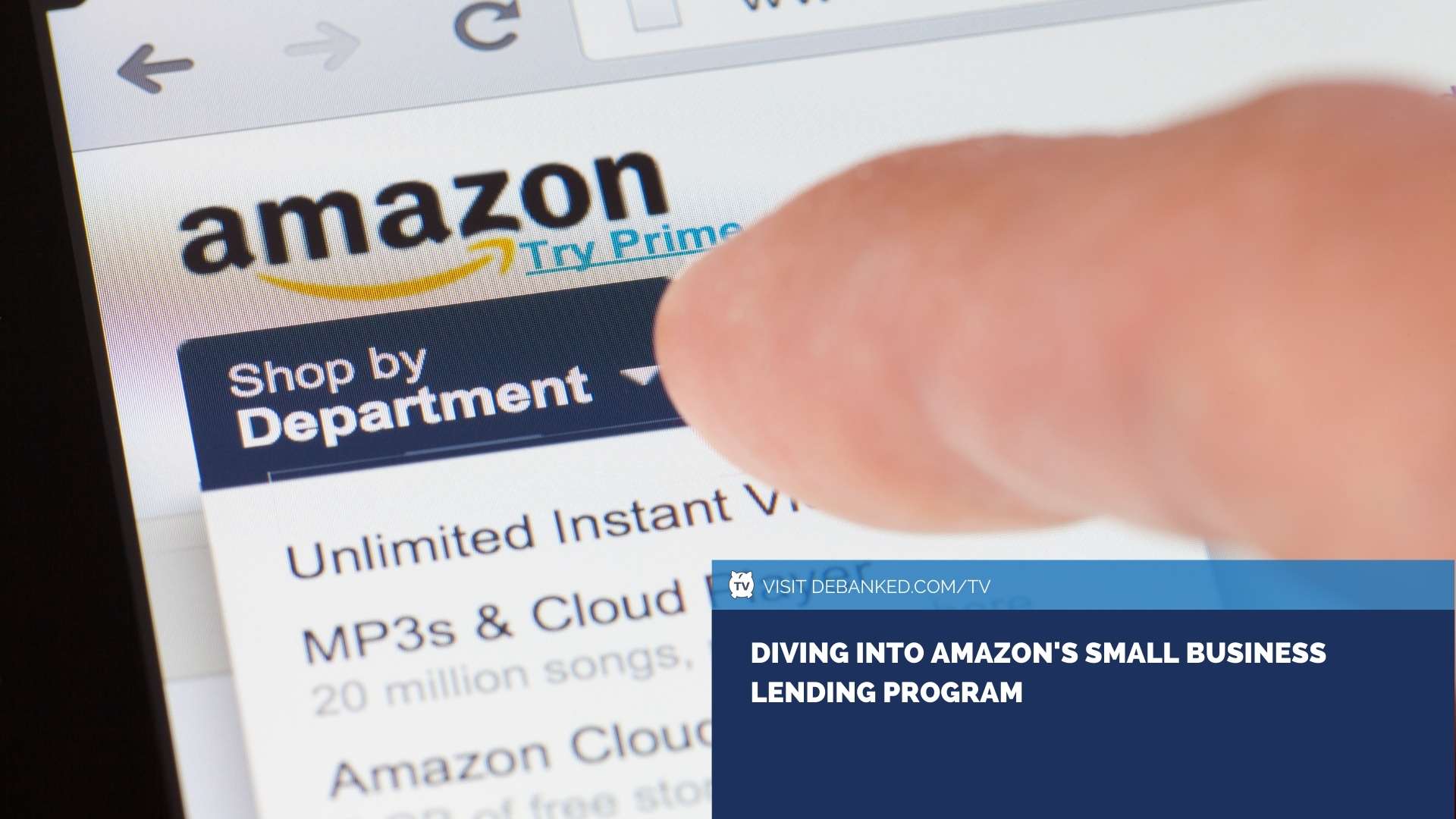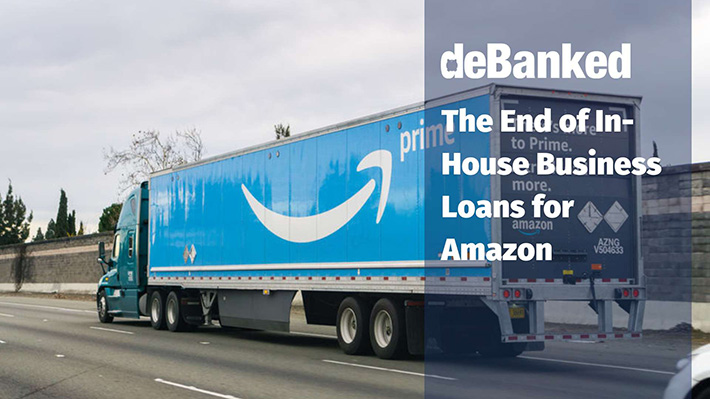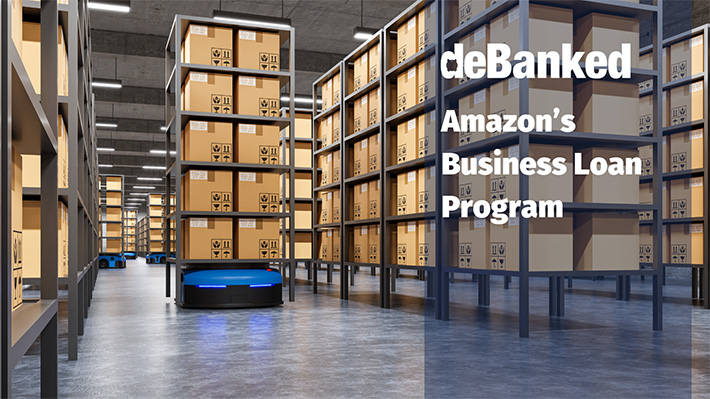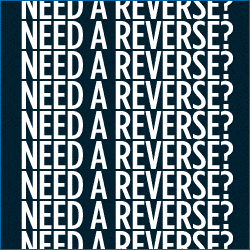 | 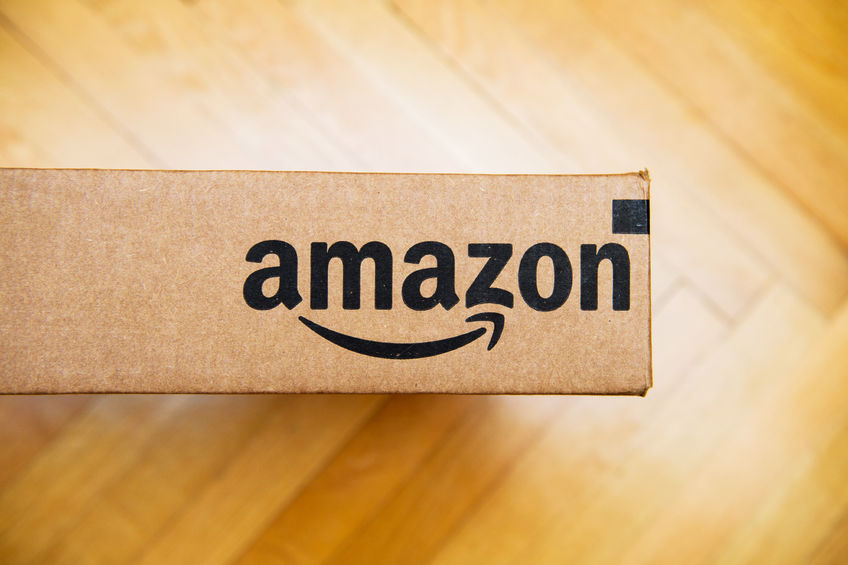 | 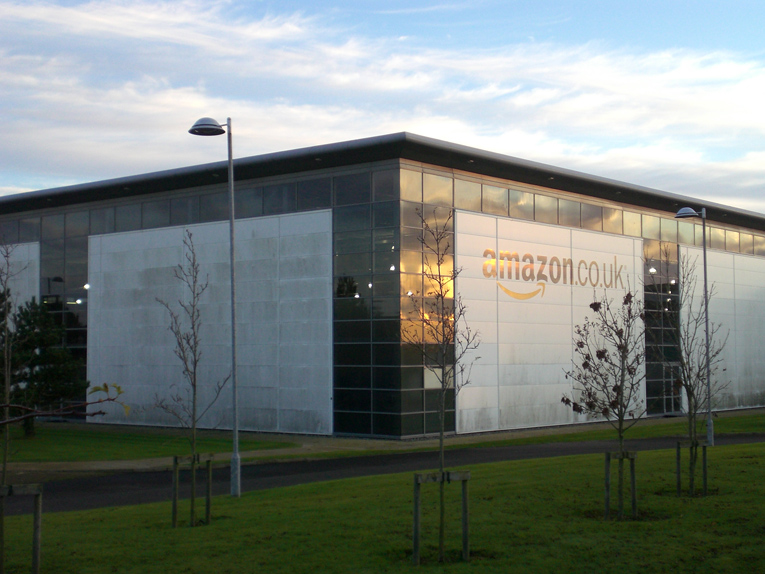 |
Related Headlines
| 10/16/2024 | Amazon Relay partners w/ Lendistry |
| 03/09/2024 | Amazon ends in-house business loans |
| 01/30/2024 | SellersFi collaborates w/ Amazon Lending |
| 01/08/2023 | Amazon to ramp up business loans |
| 11/01/2022 | Amazon launches new MCA program |
Related Videos
Diving into Amazon's Small Business Lending | End of Amazon's In-House Business Loans |
Amazon and Business Lending | |
Potential Match Found in deBanked UCC Filer list
| Company Name | Phone number | UCC Alias 1 | Alias 2 | Alias 3 | Alias 4 | Alias 5 |
| Amazon Capital Services | Amazon.com |
Stories
Amazon Discontinues Its In-House Business Loans
March 9, 2024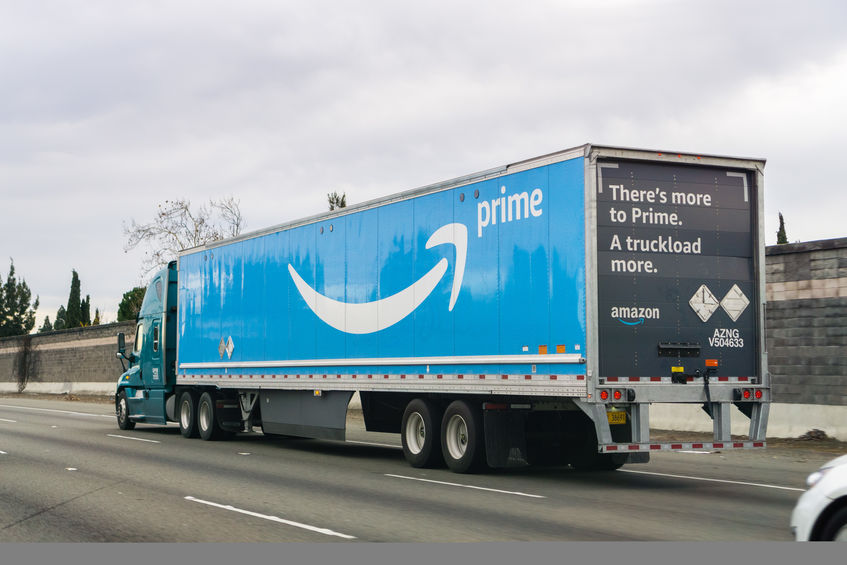 After deBanked reported that Amazon’s on-balance-sheet business loan receivables had remained steady throughout 2023, the company has abruptly decided to terminate its in-house lending program altogether.
After deBanked reported that Amazon’s on-balance-sheet business loan receivables had remained steady throughout 2023, the company has abruptly decided to terminate its in-house lending program altogether.
Through an email confirmed to Fortune, Amazon ended its in-house term loan business on March 6. That same story says that they will continue to work with third party lenders and funders as they have been doing for a while. Some of their partners include Lendistry, SellersFi, and Parafin.
The in-house program had been running since 2011 and was first discovered by deBanked in 2013.
While the company was shy about disclosing origination figures, it carried approximately $1.3B in loan receivables on its books throughout last year.
The Amazon news coincides with the announcement that business loan rival Funding Circle has decided to exit the US market. Funding Circle US is currently up for sale.
Wow we sort of called this @amazon sellers pic.twitter.com/MOWsPWxcb1
— Amazon Sellers ASGTG (@AmazonASGTG) March 7, 2024
Amazon’s On-Balance-Sheet Business Loan Program Steady
February 11, 2024 Amazon’s business loan program was relatively steady in Q4 if its seller lending receivables are any indication. Those receivables totaled $1.3B, which was in line with where it has been throughout 2023. Compared to Amazon’s overall business, which generated $170 billion in sales in Q4 alone, its in-house lending business is rarely if at all mentioned.
Amazon’s business loan program was relatively steady in Q4 if its seller lending receivables are any indication. Those receivables totaled $1.3B, which was in line with where it has been throughout 2023. Compared to Amazon’s overall business, which generated $170 billion in sales in Q4 alone, its in-house lending business is rarely if at all mentioned.
Part of this is because Amazon has forged ties with third parties to service large swaths of its sellers. These parties include Parafin, Lendistry, and more recently SellersFi.
“Amazon is committed to providing our sellers with flexible and convenient access to capital, regardless of their size,” said Tai Koottatep, director and general manager, Amazon WW B2B Payments & Lending as part of the SellersFi announcement last month. “Through this lending option with SellersFi, we’re able to strengthen that commitment and offer sellers even more opportunities to grow their business.”
“Working with the Amazon Lending team has been an exceptional experience for SellersFi,” said Leonardo Felisberto, Head of Global Business Development and Partnerships at SellersFi during that same announcement. “Their dedication to empowering sellers aligns perfectly with our mission, and together, we’ve unlocked more possibilities for e-commerce entrepreneurs. We’re hopeful this can be another step toward supporting the growth aspirations of online sellers in the US and beyond.”
SellersFi Announces Financing Solution With Amazon Lending To Provide E-Commerce Sellers Credit Lines Up to $10M
January 30, 2024Weston, FL, January, 30, 2024 – SellersFi, a global e-commerce financing and financial services company, today announced a financing solution with Amazon that will provide eligible Amazon sellers with access to credit lines of up to $10 million through Amazon Lending.
Through this relationship, eligible Amazon sellers can now seamlessly access broader lines of credit to support their Amazon stores.
“SellersFi was launched seven years ago to address e-commerce sellers’ paramount challenge: to secure the right capital to grow their businesses,” stated Ricardo Pero, co-founder and CEO of SellersFi. “This relationship with Amazon highlights our dedication to transforming e-commerce financing to empower small and medium-sized businesses with the accessible financial tools they need to focus their energy and aspirations on amplifying their businesses and attaining exceptional growth.”
Sellers face a range of hurdles in building successful online businesses including competition, order fulfillment, visitor conversion, marketing and more. Even when effectively addressing those factors, however, 32% of e-commerce startups fail due to running out of money, according to research by Marketing Signals. These lines of credit from SellersFi and Amazon Lending are meant to support sellers experiencing such challenges.
“Working with the Amazon Lending team has been an exceptional experience for SellersFi,” said Leonardo Felisberto, Head of Global Business Development and Partnerships at SellersFi. “Their dedication to empowering sellers aligns perfectly with our mission, and together, we’ve unlocked more possibilities for e-commerce entrepreneurs. We’re hopeful this can be another step toward supporting the growth aspirations of online sellers in the US and beyond.”
“Amazon is committed to providing our sellers with flexible and convenient access to capital, regardless of their size,” said Tai Koottatep, director and general manager, Amazon WW B2B Payments & Lending. “Through this lending option with SellersFi, we’re able to strengthen that commitment and offer sellers even more opportunities to grow their business.”
This announcement bolsters SellersFi’s expansion as a financial services platform. The company currently offers working capital, prepaid debit cards and digital wallets with insurance, business credit and debit, and checking accounts in the pipeline.
For more information about investment opportunities with SellersFi, please visit www.sellersfi.com. To learn more about SellersFi lines of credit via Amazon Lending, please visit sell.amazon.com/programs/amazon-lending.
About SellersFi: SellersFi, formerly SellersFunding, is a global financial technology company that utilizes AI-driven credit scoring models and extensive integration with leading e-commerce platforms to offer working capital and cash management solutions to empower e-commerce merchants looking to grow. As e-commerce evolves, SellersFi will drive the fintech innovations that allow sellers and brands to worry less about funding and finance and to focus more on growth and achieving their business goals. From inventory and marketing to product launches, international expansion, and more, thousands of e-commerce sellers trust SellersFi to achieve limitless success.
Amazon’s Business Loan Program Relatively Flat, And The Company is Now Possibly the Largest MCA Broker?
October 29, 2023 Amazon’s seller lending program, in which the company extends working capital loans to Amazon sellers to buy inventory, has been somewhat flat this year. Its seller lending receivables in Q3 were unchanged from Q1, coming in at $1.2B. It had briefly gone up in Q2 to $1.3B.
Amazon’s seller lending program, in which the company extends working capital loans to Amazon sellers to buy inventory, has been somewhat flat this year. Its seller lending receivables in Q3 were unchanged from Q1, coming in at $1.2B. It had briefly gone up in Q2 to $1.3B.
Amazon rarely mentions its seller lending business which is but a blip compared to the $143B in net sales the company recorded in just the third quarter. Despite all this cash, Amazon relies on a $1.5B secured revolving credit facility with a lender in the same way many small business lenders do to facilitate this amount of loan volume.
deBanked has been tracking the company’s seller lending receivables balance since 2016.
Amazon’s separate merchant cash advance program is not counted as part of their selling lending program. Amazon partnered up with Parafin in November 2022 to offer MCAs to their clients. One consequence of that is that Amazon sellers talk publicly in the company’s Seller Central forums and this has been no exception. There, most mentions of Parafin have so far been less than flattering.
Much of the confusion reported by sellers is centered around the percentage collected from each sale. Unlike most MCA funding companies, which either withhold a percentage of card sales or debit a fixed daily amount that can later be trued-up upon request, Amazon was previously collecting its percentage “based on whether a seller had received any disbursements, automatic or manual, in the prior week.” However, that changed this past August, according to Amazon who published the following note in their forum:
Payment is deducted from your bank account based on your current Amazon disbursement schedule. If you receive disbursements weekly, payments for your cash advance will be deducted weekly. If you receive disbursements bi-weekly, payments for your cash advance will be deducted bi-weekly. In instances where Amazon sales data is delayed in reaching Parafin, Parafin combines the payment amount with the subsequent payment to avoid debits happening on unexpected days of the week. Sellers whose payments are impacted by these instances receive emails from Parafin detailing the expected payment dates and adjusted amounts.
…
“Your merchant cash advance will be paid off automatically over time as you make successive sales-based payments. Because your offer is determined in part by your past business performance, our estimate is that you’ll pay your merchant cash advance within the estimated timeframe stated when you accepted it. If your sales ramp up or slow down, your payment amounts (and therefore the estimated payment period) may ramp up or slow down with them. The payment rate itself will not change and is a fixed percentage of monthly sales.”
Although there is some irony to Amazon playing the role of MCA broker and MCA customer service, Amazon also refers its loan-interested sellers to Lendistry and Marcus by Goldman Sachs. All of this activity started late last year just as Amazon was on pace to max out its own credit facility with its own lending program. Since then, the company’s flat business loan receivable balance might suggest that Amazon’s seller financing business is actually growing, just not on its own balance sheet since its brokering the deals out.
So who’s the biggest MCA broker in the US? Amazon generated $514B in net sales in 2022. $1B in MCA deals wouldn’t be so hard for a company already doing about a billion a year in loans. It would be quite ironic to discover that the biggest MCA broker in 2023 was Jeff Bezos, but it’s a real possibility.
Amazon’s Seller Lending Program Receivables Cool Off
April 30, 2023 According to documents purportedly obtained by Business Insider in January, Amazon had planned to increase its business loan operations in 2023, estimating that its loan receivables would eventually exceed $2B. Instead, the receivables figure has been slowly going in reverse, according to an examination of the company’s regular quarterly earnings reports. Amazon’s seller lending receivables hit a high of $1.4B in Q3 of 2022 but then ticked downward to $1.3B by year end. In Q1 of this year, those receivables had gone down again to $1.2B.
According to documents purportedly obtained by Business Insider in January, Amazon had planned to increase its business loan operations in 2023, estimating that its loan receivables would eventually exceed $2B. Instead, the receivables figure has been slowly going in reverse, according to an examination of the company’s regular quarterly earnings reports. Amazon’s seller lending receivables hit a high of $1.4B in Q3 of 2022 but then ticked downward to $1.3B by year end. In Q1 of this year, those receivables had gone down again to $1.2B.
Amazon’s Seller Lending Receivables
2016: $661M
2017: $692M
2018: $710M
2019: $863M
2020: $381M (covid)
2021: $1B
2022 (Q1): $1.1B
2022 (Q2): $1.3B
2022 (Q3): $1.4B
2022 (Q4): $1.3B
2023 (Q1): $1.2B
Not counted in these figures is financing to Amazon sellers conducted through a third party. Amazon teamed up with Parafin on merchant cash advances, Lendistry for Business Loans, and Marcus for lines of credit, for example. Data on funding from these parties is a little more difficult to come by.
Amazon’s Business Loan Trajectory
January 10, 2023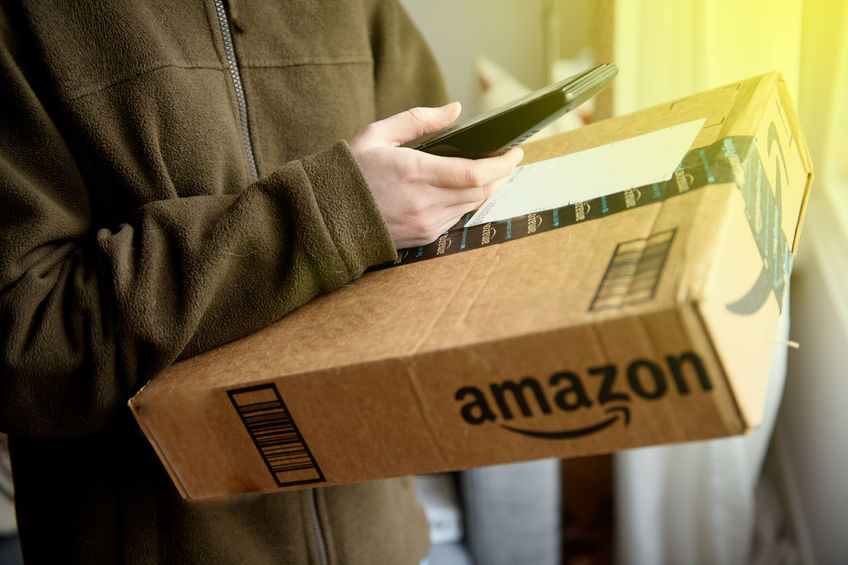 According to documents purportedly obtained by Business Insider, Amazon plans to increase its business loan operations in 2023, estimating that loan receivables will eventually exceed $2B. Insider also says that its expected loss rate is 1.34%.
According to documents purportedly obtained by Business Insider, Amazon plans to increase its business loan operations in 2023, estimating that loan receivables will eventually exceed $2B. Insider also says that its expected loss rate is 1.34%.
The receivable figure would not be all that surprising as Amazon as been on a steady trajectory upwards over the last decade with the exception of 2020 when covid struck. Its receivables reached $1.4B in Q3 2022. The year-end figure has not yet been released. $2B+ for 2023 would be in line with the historical trend.
2016: $661M
2017: $692M
2018: $710M
2019: $863M
2020: $381M (covid)
2021: $1B
2022 (Q3): $1.4B
Not counted in these figures is financing to Amazon sellers conducted through a third party. Amazon recently teamed up with Parafin on merchant cash advances, Lendistry for Business Loans, and Marcus for lines of credit, for example. Data on funding from these parties is a little more difficult to come by.
How the Amazon / Parafin Merchant Cash Advance Deal Came to Be
November 2, 2022Back in December, Parafin, then a fintech startup with 20 employees, submitted a proposal to Amazon to roll out a potential Amazon merchant cash advance product. At the time, Parafin was little known to the general public and its surprise deal with DoorDash wouldn’t even become public until a month later.
 The prospect of an MCA would not have been foreign to Amazon given that the company already offers direct business loans, lines of credit through Marcus by Goldman Sachs, and other loans thanks to a successful pilot with Lendistry. But the team behind Parafin were virtual unknowns in the merchant cash advance industry itself. The company’s 3 co-founders, including CEO Sahill Poddar, all hail from Robinhood, the investment app that became wildly popular especially with younger adults over the last several years.
The prospect of an MCA would not have been foreign to Amazon given that the company already offers direct business loans, lines of credit through Marcus by Goldman Sachs, and other loans thanks to a successful pilot with Lendistry. But the team behind Parafin were virtual unknowns in the merchant cash advance industry itself. The company’s 3 co-founders, including CEO Sahill Poddar, all hail from Robinhood, the investment app that became wildly popular especially with younger adults over the last several years.
Coincidentally, more than a dozen people employed by Parafin, including the co-founders, are former Robinhood employees, according to profiles reviewed on LinkedIn. It’s part of a trend, it appears, as other members of their team hail from well known Silicon Valley firms like Lending Club, Stripe, Funding Circle, Google, Amazon, Facebook, StreetShares, and more.
Ultimately, Parafin’s big bet paid off. On Tuesday, November 1st, Amazon announced that the Parafin team was the one it had chosen to debut its official merchant cash advance product.
“Amazon is committed to providing convenient and flexible access to capital for our sellers, regardless of their size,” said Tai Koottatep, director and general manager, Amazon WW B2B Payments & Lending, in the announcement. “Today’s launch is another milestone in strengthening Amazon’s commitment to sellers, and builds on the strong portfolio of financial solutions we already provide. This latest offering significantly expands sellers’ reach and capabilities, and broadens their access to capital in a flexible way—one that helps them control their cashflow, and by extension, their entire business.”
“We founded Parafin with the mission to grow small businesses, and we’re thrilled that we have the opportunity to do that by providing Amazon sellers with this merchant cash advance option,” said Vineet Goel, co-founder of Parafin. “It’s a privilege to count ourselves among Amazon’s suite of financial solutions, and we look forward to making a difference for Amazon.com sellers looking to expand their business.”
The product is already listed on Amazon’s website and was rolled out to some US businesses immediately. It will be available to hundreds of thousands of additional sellers by early 2023, the company claims.
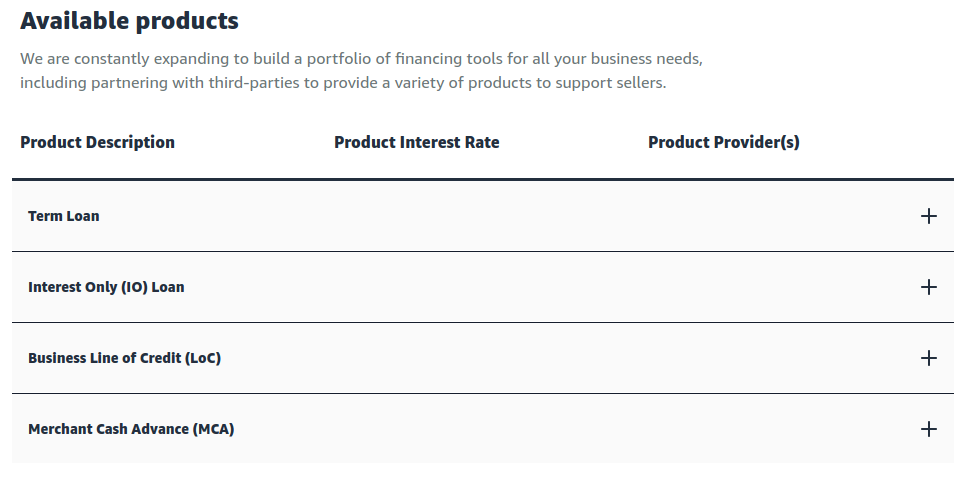
Unique to an Amazon MCA is that funding amounts can start as low as $500 and go up to $10 million.
Amazon’s entrance into the merchant cash advance market coincides wih a unique moment in the product’s history as several states are in the midst of imposing strict regulations on their sale.
A Glimpse Into Amazon Lending
October 16, 2022 When Amazon revealed it had made more than $1 billion in small business loans in 2018, many people were stunned to find out they had become so active as a lender. But other than marketing it to sellers on their own platform, the company has not attempted to draw much attention to it. They have, however, regularly disclosed “seller receivables” which are defined as “amounts due from sellers related to [their] seller lending program.” Assuming the company has consistently kept their loans on balance sheet and kept loan terms steady, one can drawn their own conclusions about the trajectory of its loan program.
When Amazon revealed it had made more than $1 billion in small business loans in 2018, many people were stunned to find out they had become so active as a lender. But other than marketing it to sellers on their own platform, the company has not attempted to draw much attention to it. They have, however, regularly disclosed “seller receivables” which are defined as “amounts due from sellers related to [their] seller lending program.” Assuming the company has consistently kept their loans on balance sheet and kept loan terms steady, one can drawn their own conclusions about the trajectory of its loan program.
Below are the loan receivables as of year-end for each year except for 2022.
2016: $661M
2017: $692M
2018: $710M
2019: $863M
2020: $381M (covid)
2021: $1B
2022 (Q2): $1.3B
Loan receivables dropped significantly during covid and are most recently at their highest level ever, almost double what it had been in 2018.
In addition to its own Amazon Lending product, Amazon is also offering loans through Lendistry and lines of credit through Marcus by Goldman Sachs. The Lendistry relationship, which piloted last year, resulted in $35M being loaned to more than 800 sellers. Because of its success, Lendistry now plans to loan $150M to Amazon sellers over the next 3 years.
The Marcus by Goldman Sachs relationship is notable because it marks Marcus’ first foray into small business lending.
High Risk MCA for a LOGISTICS COMPANY... please review the details of a deal i am trying to place below. direct lenders only thanks in advance. i have a deal which has been spinning around... |
MCA Needed for a Logistics Company... only direct lenders, please. i have a deal in which i need to fund asap. this is a logistics company which does $60k a month. this company has two ban... |

See Post... amazon e-commerce account?... |
See Post... amazon they are not getting an abl deal and a lot of factors would not be able to do 100% concentration. they will say the can do it, but will eventually restrict availability due to concentration., , getting a stand alone inventory deal done may be difficult. if the inventory is held at ama... |
See Post... amazon only or do they have other commercial customers? if so, what is the concentration with amazon? if it is above 50%, abl is not likely. a fact... |


